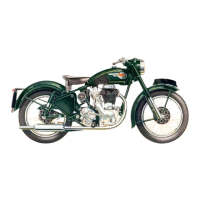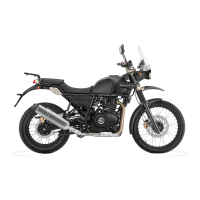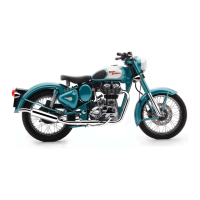fitted to the "Crusader Sports," "Super 5,"
"Continental," "Continental GT," "350 Bullet,"
and "250 Trials" have heads of greater diameter
than those fitted to the "250 Clipper" and
"Crusader 250."
The exhaust valves are of Austenitic Steel, and
those used in the cast iron cylinder head are
"Brightray" faced to ensure long service under the
higher temperatures involved.
The profile of the inlet valve and that of its
seat in the cylinder head are specially designed to
give a smooth flow of gas and to eliminate
pockets as the valve beds in. (See Section C, Fig.
4.)
11. Valve Gear
The valves are operated from the cams by
means of followers, tubular push rods and
overhead rockers. To minimise the effect of
thermal expansion on the tappet clearance steel
push rods are used in conjunction with cast iron
cylinder heads and aluminium rods with aluminium
heads. On earlier engines one-piece rockers were
used in split sintered iron bearings. Later engines
have built up rockers running in aluminium
bearings. Two compression springs are fitted to
each valve. Those fitted to the 350 Bullet
"Continental," "Continental GT," "Super 5" and
Crusader Sports engines are shorter but stronger
than those fitted to "250 Clipper" and "Crusader
250" models. On all models adjustment is made by
means of adjusting screws at the top of the push
rods after removing the cylinder head cover.
12. Timing Drive
The camshaft is located in the camshaft housing,
which is cast in with the driving-side crankcase and
runs in oil-retaining compo bushes. It is chain
driven at half engine speed from the timing
sprocket on the crankshaft, and the tightness of
the chain can be adjusted by means of a chain
tensioner inside the near-side chaincase cover.
The ignition timing is affected by the contact
breaker, which is on a common shaft with the oil
pump and is geardriven from the camshaft at half
engine speed through two steel pinions with a steel
idler pinion.
13. Ignition and Lighting System
Coil ignition and lighting are supplied from a
6-volt battery, which is charged through a rectifier
from a Lucas A.C. alternator located inside the
generator cover.
The alternator has a solid rotor with six
permanent magnets revolving within a six-pole
wound laminated stator. The rotor is mounted on
the end of the crankshaft and the stator is bolted
to the generator-side crankcase.
The arrangement is such that, in case of battery
failure, the ignition can be supplied direct from the
alternator.
(See Section G.)
14. Carburetters
"250 Clipper" and "Crusader 250"
Amal type 375/16. Monobloc
7
/
8
in. bore.
"Crusader Sports" and "250 Trials":
Amal type 376/216. Monobloc
15
/
16
in. bore.

